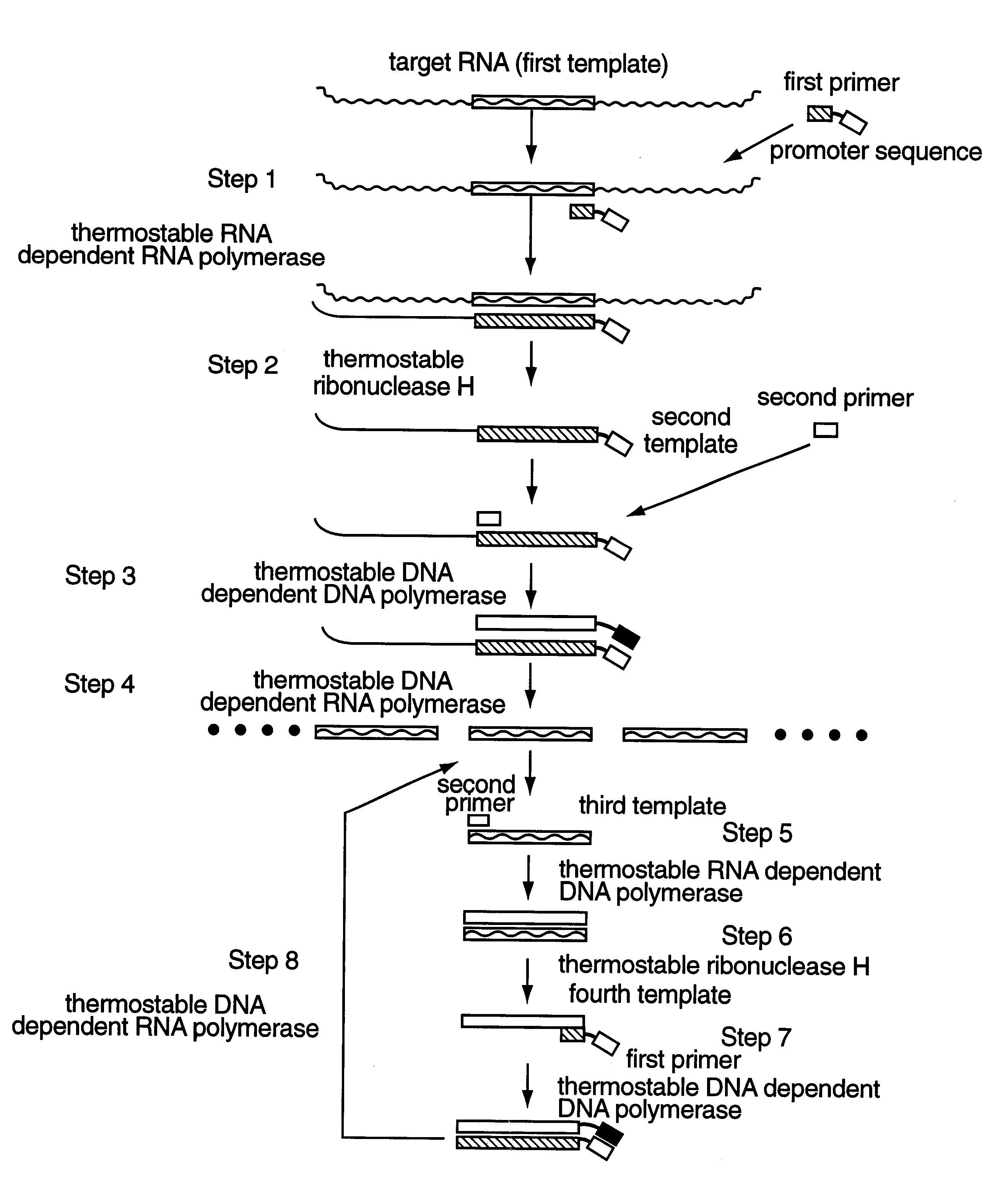Method for amplifying and detecting of target nucleic acid sequence using thermostable enzyme
a technology of thermostable enzyme and target nucleic acid, which is applied in the field of amplifying and detecting target nucleic acid sequences using thermostable enzymes, can solve the problems of long time-consuming and labor-intensive methods, and it is difficult to detect the target gene directly
- Summary
- Abstract
- Description
- Claims
- Application Information
AI Technical Summary
Problems solved by technology
Method used
Image
Examples
example 1
Amplification Reaction Using Oligonucleotide (1) Containing a Promoter Region and Oligonucleotide (2)
Using oligonucleotide (1) and oligonucleotide (2) from Reference Example 1, amplification reaction of the genome of Vibrio parahaemolyticus was carried out to obtain a large amount of RNA. The reaction condition is described below.
Reaction mixture 50 .mu.l
10 mM Tris-HCl pH8.3
50 mM KCl
6 mM MgCl.sub.2
3 mM MnCl.sub.2
0.6 mM dNTP
1 mM rNTP
20 pmol oligonucleotide (1)
20 pmol oligonucreotide (2)
Tth-DNA polymerase (manufactured by TOYOBO) 60 units
Tth-RNA polymerase (manufactured by EPICENTRE) 2.5 units
Tth-RNase H (manufactured by TOYOBO) 2 units
Reaction:
93.degree. C., 3 min
65.degree. C., 60 min
example 2
Measurement of Synthesized RNA
RNA synthesized in Example 1 was diluted, and the aliquotes of 50 .mu.l were dot blotted individually on a nylon membrane (GeneScreen plus manufactured by DuPont). As a control, 50 .mu.l of denatured genome nucleic acid of VP was dot blotted. The nylon membrane was prehybridized in a 100 .mu.l of solution containing 6.times.SSC (1.times.SSC means 0.15 M NaCl, 0.015M sodium citrate (pH7.0)), 5.times.Denhardt's solution (1.times.Denhardt's solution means 0.02% Ficoll, 0.02% polyvinylpyrrolidone, 0.02% bovine serum albumin), 1 mM EDTA, 10 .mu.g of boiled sperm from salmon (mean length is 500 bases), at 60.degree. C. for 1 hour, then the oligomer (3) prepared in Example 1 was added, and hybridization was carried out at 55.degree. C. for 1 hour. The nylon membrane was sufficiently washed in 6.times.SSC at 55.degree. C., then dried. An X-ray film (New AIF RX manufactured by FUJI) was contacted to the nylon membrane, and exposed at -80.degree. C. for a whole d...
example 3
Example of Amplification from RNA
Amplification Reaction Using Oligonucleotide (1) Containing a Promoter Region and Oligonucleotide (2)
Using oligonucleotide (1) and oligonucleotide (2), amplification of mRNA of Vibrio parahaemolyticus was carried out to obtain a large amount of RNA. The reaction condition is shown below.
Reaction mixture 50 .mu.l
10 mM Tris-HCl pH 8.3
50 mM KCl
6 mM MgCl.sub.2
3 mM MnCl.sub.2
0.6 mM dNTP
1 mM rNTP
20 pmol oligonucleotide (1)
20 pmol oligonucleotide (2)
Tth-DNA polymerase (manufactured by TOYOBO) 60 units
Tth-RNA polymerase (manufactured by EPICENTRE) 2.5 units
Tth-RNase H (manufactured by TOYOBO) 2 units
Reaction: 65.degree. C., 60min
PUM
| Property | Measurement | Unit |
|---|---|---|
| reaction temperature | aaaaa | aaaaa |
| temperature | aaaaa | aaaaa |
| temperature | aaaaa | aaaaa |
Abstract
Description
Claims
Application Information
 Login to View More
Login to View More - R&D
- Intellectual Property
- Life Sciences
- Materials
- Tech Scout
- Unparalleled Data Quality
- Higher Quality Content
- 60% Fewer Hallucinations
Browse by: Latest US Patents, China's latest patents, Technical Efficacy Thesaurus, Application Domain, Technology Topic, Popular Technical Reports.
© 2025 PatSnap. All rights reserved.Legal|Privacy policy|Modern Slavery Act Transparency Statement|Sitemap|About US| Contact US: help@patsnap.com



